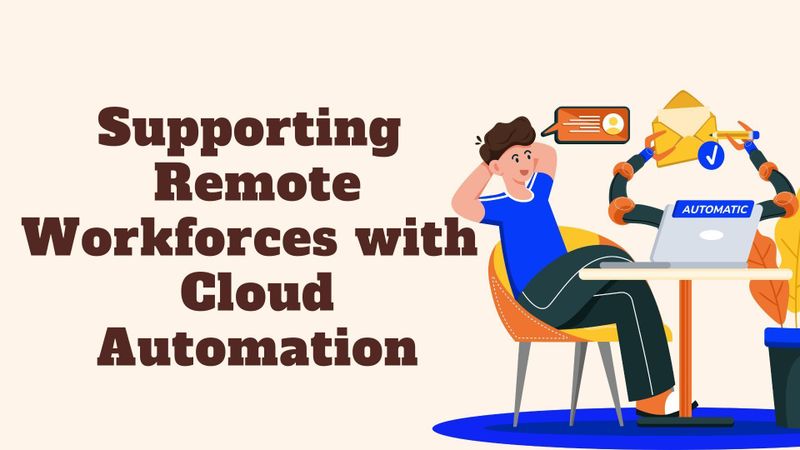Imagine this: Your team is distributed across cities, perhaps even across borders. Some work from home; others come into the office a few days a week. Sounds familiar, right?
That’s because the future of hybrid and remote work is no longer a future thing — it’s a present thing.
Yet how do you maintain tight operations and workflow when your workforce is all over the place? This is where Cloud Automation Services comes in. They enable companies to operate processes in the cloud, meaning you have the flexibility to work from anywhere, anytime.
So let’s step back and explain all that in plain language.
The Rise of Hybrid and Remote Work
If your company has moved to hybrid or remote work, you’re not alone.
- In 2024, over 80% of businesses worldwide endorsed some manner of hybrid work.
- In India, 97 per cent of employees and 98 per cent of employers expressed satisfaction with hybrid models.
- Nearly thirty per cent of the workforce now works fully remote, and 52% are hybrid.
People love flexibility. Indeed, some are even willing to accept a 5–8% pay reduction if it means they can continue to work at home. Employees at companies that support flex can be easier to retain, and organisations can save on real estate and office costs.
But this shift also presents new challenges — such as staying productive, secure and connected. Which is why automation is all the more important.
What Are Cloud Automation Services?
Cloud Automation Services allow businesses to automate things with cloud tools — especially things that are repetitive and don’t require human ingenuity.
It works like this: Instead of a human employee spending hours keying data into a computer, a bot (or “digital worker”) can do it in seconds — and from anywhere.
This can be particularly useful for hybrid and remote teams who require access to shared systems, wherever they are.
Popular cloud automation platforms include:
- UiPath Cloud
- Automation Anywhere
- Microsoft Power Automate
These tools are transforming how businesses organise work, particularly as RPA (Robotic Process Automation) trends have gained in popularity--exploring how businesses can automate tasks efficiently and accurately.
What are the uses of Cloud Automation for Hybrid Teams
Why Cloud Automation Services are a Game-Changer for the Remote and Hybrid Workforce
1. Work from Anywhere, Anytime
Cloud bots are not bound to a particular location. Whether your team is based in Mumbai or Munich, they can manage processes, sign off documents, or review reports on the fly, at a moment’s notice.
2. Save Time and Money
Automation means faster results. Companies using cloud-based automation report:
- Up to 90% time savings on repetitive tasks
- 300% return on investment in the first year
- Reduced infrastructure and IT overheads as everything is cloud-based
3. 24/7 Operations
Cloud bots don’t sleep. They can perform tasks after hours, which makes it easier for companies to operate around the clock, across the planet, without needing to hire teams that work the night shift.
4. Stronger Security
Remote work can also add new data security concerns. But cloud automation platforms have secure logins, access controls and activity monitoring to ensure everything is kept safe.
It also simplifies handling of user access — especially when someone leaves the company.
Real-World Examples of Use
Here are some of the basic ways in which businesses have been applying Cloud Automation Services:
- HR teams have enlisted bots to automatically process onboarding paperwork.
- Finance departments are automating invoice processing and expense approvals.
- Businesses mix bots with tailored chatbot solutions tools for customer service to address FAQs even when personnel are offline.
- Marketing departments integrate automation with their web design services to monitor form submissions and lead generation.
No matter what department, automation allows teams to concentrate on more impactful work, rather than tedious manual tasks.
Where RPA Trends Are Headed
You’ve probably heard about emerging trends in the popularity of RPA. These include:
- No-code tools (anyone can make a bot, no programming required!)
- Unstructured data learning powered by AI automation
- Support for cloud apps including Google Workspace, Microsoft 365 and Slack These are all trends that are making it easier than ever for hybrid and remote teams to maintain visibility and productivity.
Getting Started with Cloud Automation Services
If you’re interested in adopting Cloud Automation Services, you might follow these steps:
- Begin with small-scale automation: Automate one or two tasks, such as sending out reminders or processing invoices.
- Choose the correct platform: Find a cloud offering that is user-friendly, secure and seamless with your current systems.
- Train your team: Ensure your employees who are working remotely are trained on the tools. Many platforms provide straightforward, guided tutorials.
- Connect it all together: Integrate your custom chatbot development, CRM, email, and even web development and design into your sales funnel for total platform automation.
Final Thoughts
Hybrid and remote work is here to stay — and it’s changing the way businesses work. But with the appropriate tools, you needn’t fear a sluggish process, miscommunication, or data security.
Cloud Automation Services offers the agility, speed and control that your team needs regardless of whether they are in the office or working remotely. And with RPA trends changing, alongside intelligent services such as web designing services and custom chatbot development, your business can automate more and worry even less.
It’s time to let the cloud help with the heavy lifting—so your people can focus on what matters most.






Top comments (0)